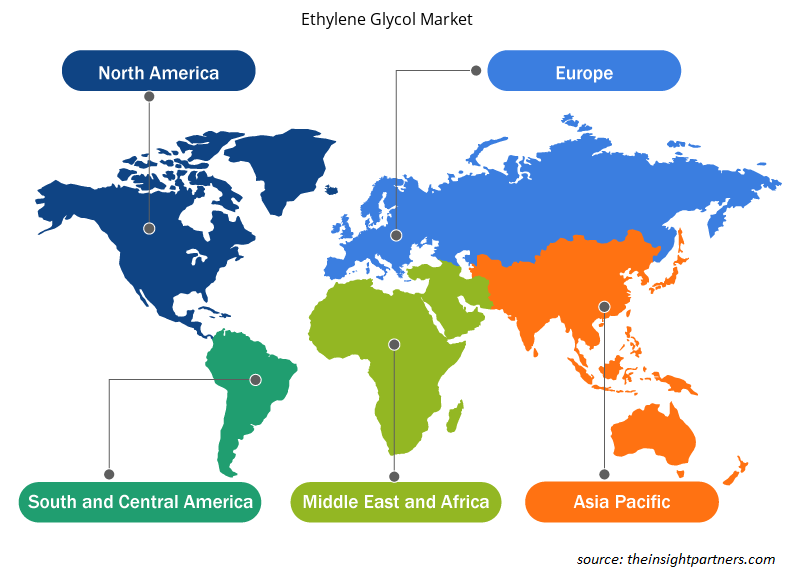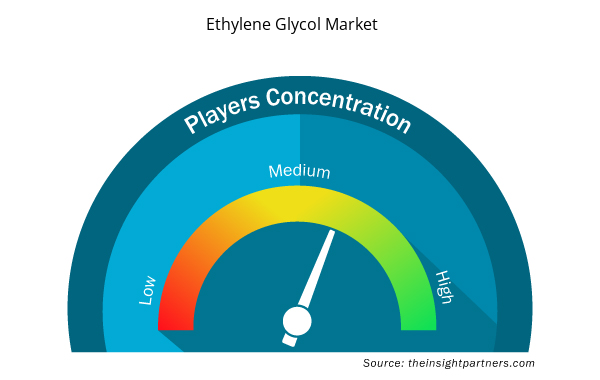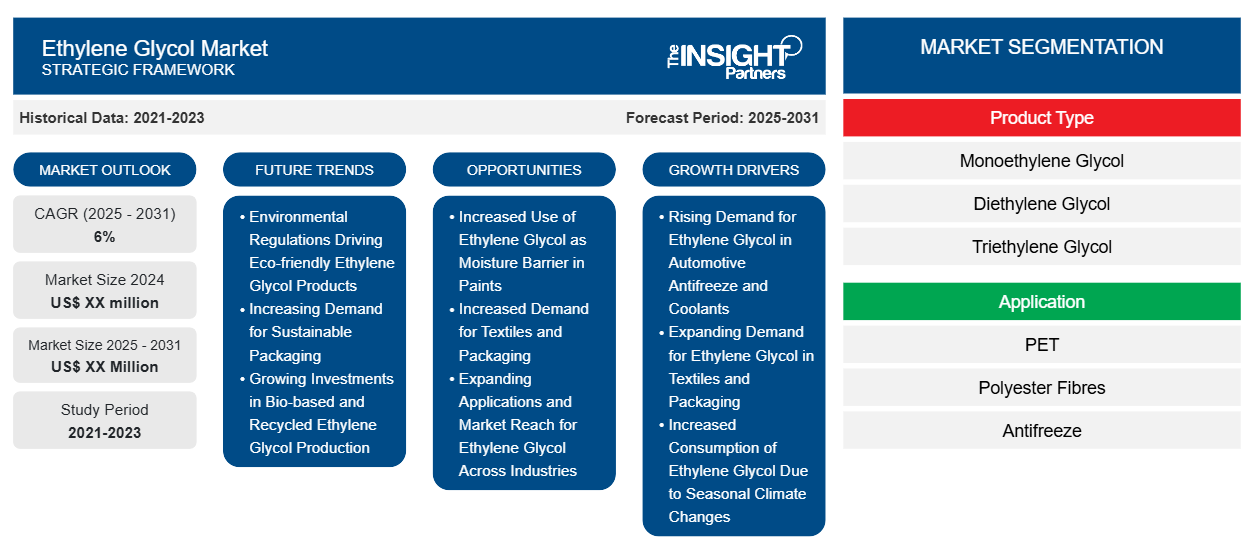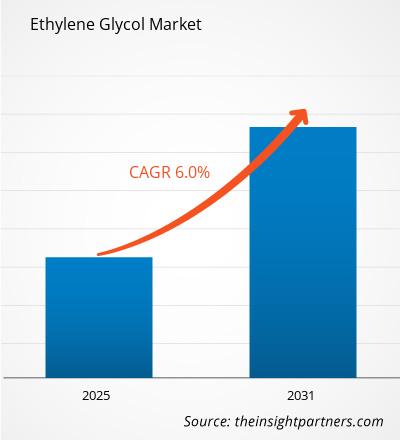Se espera que el mercado de etilenglicol registre una CAGR del 6% entre 2024 y 2031, con un tamaño de mercado que se expandirá de US$ XX millones en 2024 a US$ XX millones en 2031.
El mercado de etilenglicol cubre el análisis por tipo de producto (monoetilenglicol (MEG), dietilenglicol (DEG), trietilenglicol (TEG)); aplicación (PET, fibras de poliéster, anticongelante, otros) y geografía (América del Norte, Europa, Asia Pacífico, Medio Oriente y África, y América del Sur y Central). El etilenglicol es un líquido incoloro de sabor dulce producido a partir de óxido de etileno. La fabricación de etilenglicol a partir de óxido de etileno coproduce dietilenglicol (DEG) y trietilenglicol (TEG). El etilenglicol se utiliza principalmente en la producción de fibra de poliéster, resinas para botellas de PET y películas.
Propósito del Informe
El informe sobre el mercado del etilenglicol de The Insight Partners tiene como objetivo describir el panorama actual y el crecimiento futuro, los principales factores impulsores, los desafíos y las oportunidades. Esto proporcionará información a diversas partes interesadas del negocio, como:
- Proveedores/fabricantes de tecnología: Para comprender la dinámica cambiante del mercado y conocer las oportunidades potenciales de crecimiento, lo que les permitirá tomar decisiones estratégicas informadas.
- Inversionistas: Realizar un análisis exhaustivo de tendencias sobre la tasa de crecimiento del mercado, las proyecciones financieras del mercado y las oportunidades que existen en toda la cadena de valor.
- Órganos reguladores: Regular las políticas y vigilar las actividades del mercado con el objetivo de minimizar los abusos, preservar la confianza de los inversores y defender la integridad y la estabilidad del mercado.
Segmentación del mercado de etilenglicol
Tipo de producto
- Monoetilenglicol
- Dietilenglicol
- Trietilenglicol
Solicitud
- MASCOTA
- Fibras de poliéster
- Anticongelante
- Otros
Personalice este informe según sus necesidades
Obtendrá personalización en cualquier informe, sin cargo, incluidas partes de este informe o análisis a nivel de país, paquete de datos de Excel, así como también grandes ofertas y descuentos para empresas emergentes y universidades.
- Obtenga las principales tendencias clave del mercado de este informe.Esta muestra GRATUITA incluirá análisis de datos, desde tendencias del mercado hasta estimaciones y pronósticos.
Factores impulsores del crecimiento del mercado del etilenglicol
- Demanda creciente de etilenglicol en anticongelantes y refrigerantes para automóviles: el etilenglicol se utiliza ampliamente en la formulación de anticongelantes y refrigerantes para vehículos. Con el aumento de la producción y las ventas de maquinaria automotriz a nivel mundial, la demanda de etilenglicol para garantizar el rendimiento y la seguridad de los vehículos se disparará en los próximos años.
- Demanda creciente de etilenglicol en textiles y envases: el etilenglicol es una de las principales materias primas para la producción de tereftalato de polietileno, un material líder en las industrias textiles y de envases. Las principales aplicaciones finales del etilenglicol son, en primer lugar, los mercados textiles y de bienes de consumo, en particular las fibras de poliéster y las botellas de PET.
- Aumento del consumo de etilenglicol debido a los cambios climáticos estacionales: un cambio en las condiciones climáticas de una estación a otra requiere un mayor consumo de productos anticongelantes tanto en el hogar como en las industrias. Por lo tanto, se produce una gran demanda de etilenglicol, que es uno de los principales ingredientes utilizados en los productos anticongelantes para obtener la máxima protección contra la congelación, así como una buena eficiencia de enfriamiento.
Tendencias futuras del mercado del etilenglicol
- Normas medioambientales que impulsan el desarrollo de productos ecológicos a base de etilenglicol: Las normas medioambientales más estrictas han obligado al desarrollo de productos aún más respetuosos con el medio ambiente. Debido a que el etilenglicol es biodegradable y mucho menos tóxico que otros, ofrece una ventaja a las empresas que buscan cumplir con las iniciativas ecológicas y reducir su huella medioambiental.
- Demanda creciente de envases sostenibles: la demanda de tereftalato de polietileno aumentará conforme aumenten las tasas de crecimiento de las industrias de bebidas y envases. Esto, a su vez, aumentará directamente el consumo de etilenglicol. Cada vez más empresas buscarán soluciones de envasado sostenibles y, por lo tanto, facilitarán el crecimiento en este mercado.
- Inversiones crecientes en la producción de etilenglicol de origen biológico y reciclado: el crecimiento de los consumidores y las regulaciones sobre sostenibilidad serán los principales impulsores de la demanda de etilenglicol de origen biológico y reciclado. Para el fabricante, los requisitos globales en materia de sostenibilidad y las demandas de los consumidores seguirán atrayendo grandes inversiones en procesos de producción más ecológicos y alternativas para el etilenglicol de origen biológico y reciclado.
Oportunidades de mercado del etilenglicol
- Aumento del uso de etilenglicol como barrera de humedad en pinturas: además de sus usos como anticongelante para hormigón, el etilenglicol se ha empleado ampliamente en las industrias de la construcción. También se ha extendido su uso como barrera de humedad en pinturas. Por ejemplo, el desarrollo de infraestructuras y la expansión de las ciudades todavía están en pleno auge. Se prevé que estos factores aumenten aún más el uso de etilenglicol en materiales de construcción.
- Mayor demanda de productos textiles y embalajes: el crecimiento de la población y la creciente urbanización aumentan la demanda de bienes de consumo, incluidos productos textiles y envasados. Esto, por tanto, ofrece una oportunidad para el etilenglicol en la producción de materiales que se utilizan a medida que cambian las preferencias de los consumidores.
- Ampliación de las aplicaciones y el alcance del mercado del etilenglicol en distintas industrias: gracias a la innovación en las tecnologías de producción, la fabricación de etilenglicol se vuelve más eficiente. Al mejorar el proceso y reducir los costos, el etilenglicol se vuelve aún más disponible, con más aplicaciones y un alcance de mercado aún más amplio en diversas industrias.
Perspectivas regionales del mercado de etilenglicol
Los analistas de Insight Partners explicaron en detalle las tendencias y los factores regionales que influyen en el mercado de etilenglicol durante el período de pronóstico. Esta sección también analiza los segmentos y la geografía del mercado de etilenglicol en América del Norte, Europa, Asia Pacífico, Oriente Medio y África, y América del Sur y Central.

- Obtenga datos regionales específicos para el mercado de etilenglicol
Alcance del informe de mercado de etilenglicol
| Atributo del informe | Detalles |
|---|---|
| Tamaño del mercado en 2024 | XX millones de dólares estadounidenses |
| Tamaño del mercado en 2031 | US$ XX millones |
| CAGR global (2024 - 2031) | 6% |
| Datos históricos | 2021-2023 |
| Período de pronóstico | 2025-2031 |
| Segmentos cubiertos | Por tipo de producto
|
| Regiones y países cubiertos | América del norte
|
| Líderes del mercado y perfiles de empresas clave |
|
Densidad de actores del mercado de etilenglicol: comprensión de su impacto en la dinámica empresarial
El mercado del etilenglicol está creciendo rápidamente, impulsado por la creciente demanda de los usuarios finales debido a factores como la evolución de las preferencias de los consumidores, los avances tecnológicos y una mayor conciencia de los beneficios del producto. A medida que aumenta la demanda, las empresas amplían sus ofertas, innovan para satisfacer las necesidades de los consumidores y aprovechan las tendencias emergentes, lo que impulsa aún más el crecimiento del mercado.
La densidad de actores del mercado se refiere a la distribución de las empresas o firmas que operan dentro de un mercado o industria en particular. Indica cuántos competidores (actores del mercado) están presentes en un espacio de mercado determinado en relación con su tamaño o valor total de mercado.
Las principales empresas que operan en el mercado del etilenglicol son:
- Compañía química Dow
- ExxonMobil
- Grupo de Plásticos Formosa
- Petroquímica Honam
- Ineos
Descargo de responsabilidad : Las empresas enumeradas anteriormente no están clasificadas en ningún orden particular.

- Obtenga una descripción general de los principales actores clave del mercado de etilenglicol
Puntos de venta clave
- Cobertura integral: el informe cubre de manera integral el análisis de productos, servicios, tipos y usuarios finales del mercado de etilenglicol, proporcionando un panorama holístico.
- Análisis de expertos: el informe se compila sobre la base de un profundo conocimiento de expertos y analistas de la industria.
- Información actualizada: El informe asegura relevancia comercial debido a su cobertura de información reciente y tendencias de datos.
- Opciones de personalización: este informe se puede personalizar para satisfacer los requisitos específicos del cliente y adaptarse adecuadamente a las estrategias comerciales.
Por lo tanto, el informe de investigación sobre el mercado del etilenglicol puede ayudar a abrir camino para descifrar y comprender el escenario de la industria y las perspectivas de crecimiento. Si bien puede haber algunas preocupaciones válidas, los beneficios generales de este informe tienden a superar las desventajas.
- Análisis histórico (2 años), año base, pronóstico (7 años) con CAGR
- Análisis PEST y FODA
- Tamaño del mercado Valor/volumen: global, regional, nacional
- Industria y panorama competitivo
- Conjunto de datos de Excel


- Saudi Arabia Drywall Panels Market
- Cell Line Development Market
- Asset Integrity Management Market
- Ceramic Injection Molding Market
- Cling Films Market
- Lymphedema Treatment Market
- Vision Guided Robotics Software Market
- Artificial Intelligence in Defense Market
- Sexual Wellness Market
- Vision Care Market

Report Coverage
Revenue forecast, Company Analysis, Industry landscape, Growth factors, and Trends

Segment Covered
This text is related
to segments covered.

Regional Scope
North America, Europe, Asia Pacific, Middle East & Africa, South & Central America

Country Scope
This text is related
to country scope.
Preguntas frecuentes
The growing demand the demand for bio-based and recycled ethylene glycol is an emerging trend in the market.
The Asia Pacific market is expected to account for the highest CAGR during the forecast period owing to the growing construction industry in the region.
The MEG product segment accounted for the largest market share in 2023.
The growing demand from formulation of vehicle antifreeze and coolants is a key driver in the market.
Dow Chemical Company, ExxonMobil, Formosa Plastics Group, Honam Petrochemicals, Ineos, Nouryon, Reliance Industries Limited, SABIC, Shell Chemical, and Sinopec are some of the key players operating in the market.
The Ethylene Glycol Market is estimated to witness a CAGR of 6% from 2023 to 2031
Trends and growth analysis reports related to Chemicals and Materials : READ MORE..
1.Dow Chemical Company
2.ExxonMobil
3.Formosa Plastics Group
4.Honam Petrochemicals
5.Ineos
6.Nouryon
7.Reliance Industries Limited
8.SABIC
9.Shell Chemical
10.Sinopec
The Insight Partners performs research in 4 major stages: Data Collection & Secondary Research, Primary Research, Data Analysis and Data Triangulation & Final Review.
- Data Collection and Secondary Research:
As a market research and consulting firm operating from a decade, we have published and advised several client across the globe. First step for any study will start with an assessment of currently available data and insights from existing reports. Further, historical and current market information is collected from Investor Presentations, Annual Reports, SEC Filings, etc., and other information related to company’s performance and market positioning are gathered from Paid Databases (Factiva, Hoovers, and Reuters) and various other publications available in public domain.
Several associations trade associates, technical forums, institutes, societies and organization are accessed to gain technical as well as market related insights through their publications such as research papers, blogs and press releases related to the studies are referred to get cues about the market. Further, white papers, journals, magazines, and other news articles published in last 3 years are scrutinized and analyzed to understand the current market trends.
- Primary Research:
The primarily interview analysis comprise of data obtained from industry participants interview and answers to survey questions gathered by in-house primary team.
For primary research, interviews are conducted with industry experts/CEOs/Marketing Managers/VPs/Subject Matter Experts from both demand and supply side to get a 360-degree view of the market. The primary team conducts several interviews based on the complexity of the markets to understand the various market trends and dynamics which makes research more credible and precise.
A typical research interview fulfils the following functions:
- Provides first-hand information on the market size, market trends, growth trends, competitive landscape, and outlook
- Validates and strengthens in-house secondary research findings
- Develops the analysis team’s expertise and market understanding
Primary research involves email interactions and telephone interviews for each market, category, segment, and sub-segment across geographies. The participants who typically take part in such a process include, but are not limited to:
- Industry participants: VPs, business development managers, market intelligence managers and national sales managers
- Outside experts: Valuation experts, research analysts and key opinion leaders specializing in the electronics and semiconductor industry.
Below is the breakup of our primary respondents by company, designation, and region:

Once we receive the confirmation from primary research sources or primary respondents, we finalize the base year market estimation and forecast the data as per the macroeconomic and microeconomic factors assessed during data collection.
- Data Analysis:
Once data is validated through both secondary as well as primary respondents, we finalize the market estimations by hypothesis formulation and factor analysis at regional and country level.
- Macro-Economic Factor Analysis:
We analyse macroeconomic indicators such the gross domestic product (GDP), increase in the demand for goods and services across industries, technological advancement, regional economic growth, governmental policies, the influence of COVID-19, PEST analysis, and other aspects. This analysis aids in setting benchmarks for various nations/regions and approximating market splits. Additionally, the general trend of the aforementioned components aid in determining the market's development possibilities.
- Country Level Data:
Various factors that are especially aligned to the country are taken into account to determine the market size for a certain area and country, including the presence of vendors, such as headquarters and offices, the country's GDP, demand patterns, and industry growth. To comprehend the market dynamics for the nation, a number of growth variables, inhibitors, application areas, and current market trends are researched. The aforementioned elements aid in determining the country's overall market's growth potential.
- Company Profile:
The “Table of Contents” is formulated by listing and analyzing more than 25 - 30 companies operating in the market ecosystem across geographies. However, we profile only 10 companies as a standard practice in our syndicate reports. These 10 companies comprise leading, emerging, and regional players. Nonetheless, our analysis is not restricted to the 10 listed companies, we also analyze other companies present in the market to develop a holistic view and understand the prevailing trends. The “Company Profiles” section in the report covers key facts, business description, products & services, financial information, SWOT analysis, and key developments. The financial information presented is extracted from the annual reports and official documents of the publicly listed companies. Upon collecting the information for the sections of respective companies, we verify them via various primary sources and then compile the data in respective company profiles. The company level information helps us in deriving the base number as well as in forecasting the market size.
- Developing Base Number:
Aggregation of sales statistics (2020-2022) and macro-economic factor, and other secondary and primary research insights are utilized to arrive at base number and related market shares for 2022. The data gaps are identified in this step and relevant market data is analyzed, collected from paid primary interviews or databases. On finalizing the base year market size, forecasts are developed on the basis of macro-economic, industry and market growth factors and company level analysis.
- Data Triangulation and Final Review:
The market findings and base year market size calculations are validated from supply as well as demand side. Demand side validations are based on macro-economic factor analysis and benchmarks for respective regions and countries. In case of supply side validations, revenues of major companies are estimated (in case not available) based on industry benchmark, approximate number of employees, product portfolio, and primary interviews revenues are gathered. Further revenue from target product/service segment is assessed to avoid overshooting of market statistics. In case of heavy deviations between supply and demand side values, all thes steps are repeated to achieve synchronization.
We follow an iterative model, wherein we share our research findings with Subject Matter Experts (SME’s) and Key Opinion Leaders (KOLs) until consensus view of the market is not formulated – this model negates any drastic deviation in the opinions of experts. Only validated and universally acceptable research findings are quoted in our reports.
We have important check points that we use to validate our research findings – which we call – data triangulation, where we validate the information, we generate from secondary sources with primary interviews and then we re-validate with our internal data bases and Subject matter experts. This comprehensive model enables us to deliver high quality, reliable data in shortest possible time.


 Obtenga una muestra gratuita de este informe
Obtenga una muestra gratuita de este informe